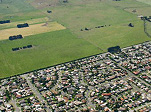PLANNED: There has been a lot of discussion of late about the right growth strategy for South East Queensland, and which method will house more people, in a fast amount of time.
As you’ve probably heard it hundreds of times before, the growth of South East Queensland is extremely high for a western city. No matter what you think, 1000 people a week is significantly large.
The government has outlined a proposal to build three new cities on the outskirts of Brisbane. These three cities are in the geographical areas of the Ripley Valley, Flagstone and Yarrabilba and are aimed at absorbing some of Brisbane’s future growth. The question that should be asked is, do we want to live out there?
The government states that local employment will be provided so that we do not see hour and a half long commutes to Brisbane, however the key concern from a new urban perspective is how people will get from A to B in these new areas? The answer to that will most certainly be cars.
If plans of suburban subdivision rather then medium density are carried out, frequent public transport services will not be available. And then the question that should be asked is, what’s the point?
If we are simply constructing another suburban nightmare, where it takes you more then 20 minutes to get to work, why go down this track? why not something smarter?
A video which can be watched above, constructed by the American Makeover web channel has constructed a video outlining a few problems of urban sprawl. Stating that the “greatest threat to our planet is” indeed urban sprawl, which makes complete sense when you factor in peak oil projections and decades of environmental problems associated to land clearing.
To compare the two urban planning methods, consider this. You want to live in a big house, with a big yard (the Australian dream). Now times this by two hundred and fifty thousand (the projected dwellings needed for Brisbane by 2030).
It is simply not possible to be able to walk to work, the park, the gym, the local store etc etc if you build low density housing, its a known fact proven millions of times over. The suburban way of living entails getting into a vehicle and driving everywhere.
The video above – “SPRAWLANTA”, done by the same people as “Built to last” illustrates how people in the American city of Atlanta drive a staggering combined length of Earth to the Sun and a little way back, every single day.
Now if cars were 100% environmentally friendly, you would probably say this fact is fine, it doesn’t mean all that much. However the benefits of living close to where you work, shop, eat, socialise is beyond argument.
You could argue that Suburbia provides more space for children who can play freely in the backyard. However, just give that one more thought. Kids are social, they prefer to play and meet other children.
Why not have more local parks and playgrounds 500 metres away? Of course apartment living has always been a no no for families, and that is something for future developers to work out, but the four simple and key attributes of new urban communities are the following:
- Frequent public transport
- Being able to walk to public amenities such as local shops, parks, schools, theatre etc
- Good level of local employment to self sustain the community
- Grid road system for better connectivity
These attributes are simple, yet difficult to achieve in low density areas. Take the suburban areas of Forest Lake or Northlakes as an example, these two areas, although having large golf courses or lakes as recreational space isn’t so great if your house isn’t directly opposite them and want to walk to these spaces.
These areas are designed to limit local through flow traffic by using curved roads and Cul-de-sacs, and as a consequence, people are forced to drive.
Is this sustainable? or social?
Lets stop and think about the way we currently build our communities and keep an open mind to new ideas so that future generations can live in exciting, social and car-free communities. This is not a brainwashing or propaganda movement, but simply the answer, and the alternative to car dependant urban sprawl.
People say that there is no silver bullet to our growth problems, but take one look at New Urbanism and you will find that the silver bullet has been right in front of us. Methods used by past generations once before us can be used again to better design our communities.


